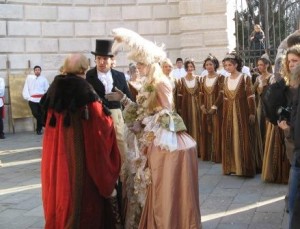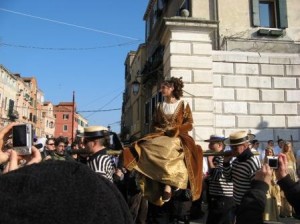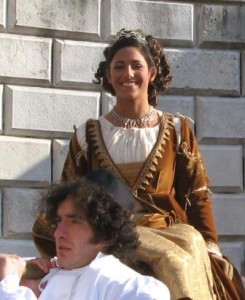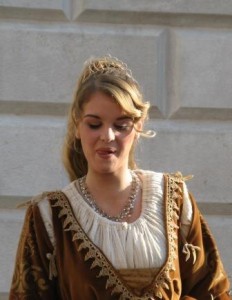One of a couple of events which the organizers of Carnival have revived after rummaging around in Venetian history is a beauty pageant which is based on one of the more dramatic exploits in the city’s entire life story. And a beauty pageant.
It is called the festa delle Marie (ma-REE-eh), which is plural for Maria. There were 12, actually or temporarily named Maria, and what happened to them was not only an exciting demonstration of the fledgling republic’s developing power, but a great way to add a party to the calendar.

The story begins around the year 943, though documented accounts date from 1039. Some details remain open to scholarly debate, but the outline of the episode goes like this:
On the annual feast of the Madonna Candelora (February 2, also known as the feast of the Purification of the Blessed Virgin Mary), Venetians not only went to mass, they also organized an entertainment disguised as an act of municipal and Christian charity. Or vice versa. In any case, they were very good at this, I want to say without sarcasm — a skill that civic leaders today might consider acquiring.
Taking the established custom of blessing girls who were newlyweds on February 2, somebody thought it would be wonderful to choose 12 poor girls and include them in the event.

These twelve damsels had to be poor (otherwise the charitable part of the operation would be meaningless), obviously had to be engaged, and of course they had to be divinely beautiful — or at least more beautiful than any other poor engaged girl in their district.
The patrician families in their respective districts took up a collection to provide them with dowries; the doge lent them masses of jewelry of gold and precious stones from the state treasury, and they went in a procession of boats to the church of San Pietro di Castello, where they were blessed by the bishop in a sumptuous ceremony in the presence of the doge himself and all the noble families (on February 2, obviously).
The girls then resumed their procession, going to the Doge’s Palace (which it’s entirely possible they had never even seen; until recently, life here was generally limited to your own little neighborhood), where they were the centerpiece of a magnificent reception. Then everyone climbed aboard the Bucintoro, the doge’s ceremonial barge (in those early days it did not resemble the elaborate final version made famous in paintings by Canaletto, but still — the doge’s barge) and, followed by innumerable boats, went up the Grand Canal to the Rialto, then down the canal of the Fondaco dei Tedeschi to Santa Maria Formosa, where more solemn ceremonies awaited them in the church.

Things had gone along like this to general rejoicing until the year 943, when a crew of pirates — led by a certain Gaiolo, an Istrian pirate notorious for stealing Venetians and making slaves of them — burst into the church with his trusty marauders and made off with the girls. The Marias may have had a certain commercial value, but their jewelry must have been utterly amazing.
The doge — Pietro Candiani III — hastily organized a band of hardy men (I am not making this up) and they went racing off in hot pursuit, doge included. They caught up with the pirates near Caorle, slew them to a man, and carried home the brides (and their jewelry) in triumph.
If there had been a festa before, from this point it became ever more elaborate; not only to celebrate the 12 girls (as before), but now to commemorate the daring rescue of the 12 girls. Each February 2 the chosen girls were temporarily re-baptized with the name Maria, they were invited to all sorts of parties and receptions and balls and even mass in the major churches of the city. Venetians considered it good luck merely to be able to get near them. All this went on for nine days.

At that point somebody conveniently decided that it was wrong for people to have become fixated on this festival as a great way to ogle some beautiful babes when they should have been focusing on the religious aspect of the day.
So they eliminated the girls altogether and substituted figures made of wood — specifically, large slabs of wood cut out along the silhouette of a beautiful poor girl. Think paper dolls.
People hated it, and threw stones and vegetables at the wooden Marias when they passed. So the government passed a law, in 1349, forbidding the throwing of stones and vegetables at the wooden Marias. But the festa was obviously destined to die, and in 1379 it was suppressed altogether.

But not everywhere. The reviled wooden stand-ins, called “Marione de tola” in Venetian (big Marys made of planks), were taken up by the French in reduced form, and before you can say zut alors, they had become known as Marionets or petits Marions, and then marionette.
Now it’s Venice, February 7, 2010, and the Marias are back. For the past few years, part of the opening festivities of Carnival has been the Festa delle Marie, a procession of costumed re-enactors accompanying 12 beautiful girls which wends on foot from San Pietro di Castello to San Marco. The girls are chosen by a jury from many, many applications, and I doubt that they have to be either poor or engaged anymore. But they do need to be beautiful.
For a few years, back in the Nineties (I seem to recall 1996), there was another element: the Regata delle Marie. Rowing races were historically part of any important Venetian festivity, and this one was intended for pairs of women rowing mascaretas. The idea was that both women (or girls) had to be amateurs, rowers who had never participated in the official city races.

But we disentangled ourselves and rowed like Istrian pirates being pursued by an angry doge, and back up into the rio di Quintavalle to the finish line in front of the church. After all that, we actually came in fourth, which meant we won a pennant, which is all that matters. I also remember that experience because the second we crossed the finish line, Magdalena said, “I’m never racing again.” I never asked her why.
The race did well enough for a couple of years, then people began bending the rules into all kinds of weird shapes till the participants were basically the same people on the official roster. So the race, like the original festival, fizzled out, at least as part of Carnival. It’s now held in June, in honor of San Pietro. Nice thought, but nothing to do with pirates and doges.

And it’s fun for the onlookers too, because — some things never change — they get to look at beautiful girls in fancy clothes.




2 Comments
Nice website cool to see this.